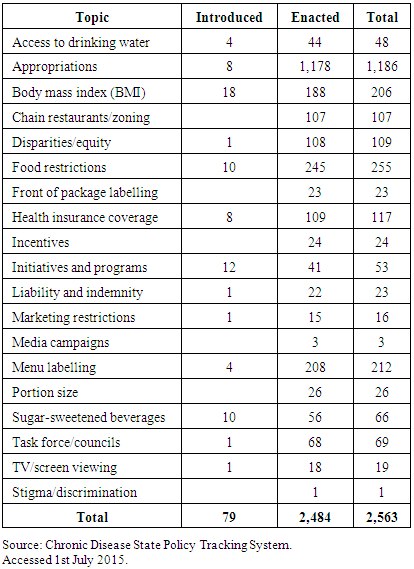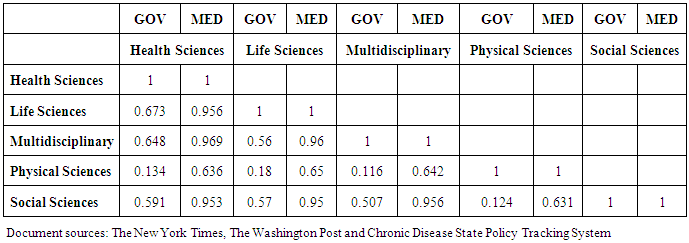-
Paper Information
- Previous Paper
- Paper Submission
-
Journal Information
- About This Journal
- Editorial Board
- Current Issue
- Archive
- Author Guidelines
- Contact Us
Food and Public Health
p-ISSN: 2162-9412 e-ISSN: 2162-8440
2016; 6(5): 140-148
doi:10.5923/j.fph.20160605.05

Expression of Science in Public Policies and Media Reports Related to Obesity in the United States
Caroline P. Spanhol-Finocchio1, Homero Dewes2
1School of Management and Business, Federal University of Mato Grosso do Sul, Campo Grande, Mato Grosso do Sul, Brazil
2Biosciences Institute and Centre for Agribusiness Studies, Federal University of Rio Grande do Sul, Rio Grande do Sul, Brazil
Correspondence to: Caroline P. Spanhol-Finocchio, School of Management and Business, Federal University of Mato Grosso do Sul, Campo Grande, Mato Grosso do Sul, Brazil.
| Email: |  |
Copyright © 2016 Scientific & Academic Publishing. All Rights Reserved.
This work is licensed under the Creative Commons Attribution International License (CC BY).
http://creativecommons.org/licenses/by/4.0/

Obesity is a serious global public health problem. Many countries seek ways to solve them from public policies. Therefore, the purpose of this paper is to identify how government and media use science to frame obesity in the United States. The documentary research was carried out considering public policies and media articles related to food and obesity, covering a period from 2003 to 2013. The database consisted of 1,592 documents from the US government and 1,168 US media reports. Text mining was used to extract information from the texts by applying a specific analysis structure that was built on scientific dimensions expressed by their respective words. The results show that US government and media use the elements expressed by contemporary science in different proportions in their respective agendas related to obesity, highlighting the health and multidisciplinary sciences. These findings can be used to support government decisions related to investments in science and actions for reverse the obesity epidemic. There are two primary aspects of this study which are original: the application of text-mining techniques as a particular tool to extract knowledge from documents and to categorize them according to specific dimensions, in this case, in scientific dimensions.
Keywords: Agenda-setting, Food security, D-words, Jaccard index, Obesogenic, Public health
Cite this paper: Caroline P. Spanhol-Finocchio, Homero Dewes, Expression of Science in Public Policies and Media Reports Related to Obesity in the United States, Food and Public Health, Vol. 6 No. 5, 2016, pp. 140-148. doi: 10.5923/j.fph.20160605.05.
Article Outline
1. Introduction
- Obesity has reached epidemic levels and became a major cause of disease worldwide. Excess adiposity is a major risk factor for morbidity and mortality from diseases such as diabetes, cardiovascular disease, and other comorbidities [1]. Approximately 2.8 million people die each year from excessive weight or obesity [2]. Most of these diseases are caused by unhealthy habits, such as consumption of processed foods, meat, and dairy products with high levels of saturated fat, and reduction in physical activities [3-6]. Furthermore, obesity has negative individual and social effects, including rising health costs, decreased life expectancy, reduced social status, and job satisfaction [7]. Obesity has become a worldwide epidemy, occurring in both developed and developing countries, reaching all social classes and affecting men and women of all ages. In the United States, for example, obesity has grown rapidly in all regions of the country [8]. In 1999–2000, 27.5% of American men were obese. In 2009–2010, the prevalence of obesity among men increased to 35.5%. In 1999–2000, approximately 33.4% of American women were obese. By 2009–2010, this rate had increased to 35.8% [8].According to the Organisation for Economic Co-operation and Development [9], the United States has the highest rates of obesity among adults in all countries. The data also revealed the rapid increase in obesity in Mexico, which ranks second with an obesity rate of 32.4%, followed by New Zealand (31.3%), Hungary (28.5%), Australia (28.3%), and Canada (25.4%).According to the scientific literature, many variables contribute to obesity such as biological, behavioural, and environmental. Many authors have pointed to the existence of environmental vectors responsible for pandemic obesity related to the food supply and the practice of physical exercise [10-13]. Given the severity and extent of the obesity problem, Niggel [14] pointed out that obesity has reached the policy agenda of many countries, particularly in the United States, highlighting the importance of public policies for its prevention and control. Considering this context, this research sought to answer the following questions: i) Which disciplinary areas of science are referred to in the documents related to obesity by the US government and in the American media? (ii) Are there similarities in the way these two kinds of public documents follow the trends of science?This study aims at identifying how government and media scientifically frame obesity. In other words, this study explores obesity-related state policymaking in each state in the US, looking at the scientific areas that support such policies and comparing these scientific frameworks with those found in the media. The findings were discussed considering the agenda-setting and framing theories. The objective of this analysis is to assist in understanding the relationship between the policy and the media agendas, and to examine how both stakeholders build a rational fundament for public awareness and action facing the challenges of pandemic obesity. To address these questions, this study carried out a content analysis of scientific papers, media reports, and US state government documents published in the period of 2003–2013, using the methodology of text mining based on terminology usage.
2. Material and Methods
2.1. Documents Collection
- First, we selected scientific articles made available on the ISI Web of Knowledge (Web of Science), using the search keywords ‘food AND consumption AND obesity OR obesogen*’. The set of keywords used in the search for scientific articles were obtained through expert consultation on the subject and from the literature review. We noted that one factor that contribute to obesity are unhealthy eating habits, it explain the inclusion of ‘food and consumption’ in the search for scientific papers. This step provided the basis for the analysis of both the media and the public policies introduced or enacted by the 50 states of the US and the District of Columbia, in the period of 2003–2013. In the second step, we used the keywords ‘food AND obesity AND policy’ to search media reports published in two major US newspapers, selected because of their high average circulation in the country: The New York Times and The Washington Post.Lastly, we searched for the policies available online according to the classification of the CDC’s Chronic Disease State Policy Tracking System. This study followed the definition of ‘obesity-related state policy’ for state legislation or regulation classified into the category ‘obesity’. In all steps, were used the web-onsite available search tools.At the end of the data collection process, we obtained 4,648 scientific articles, 1,168 media articles, and 1,592 documented laws or regulations.
2.2. Construction of the Text-Mining Tool for Content Analysis
- The scientific articles identified with the previously chosen keywords were classified according to their respective disciplinary areas, based on the editorial scope of the journal where they were published. Articles published in journals with broad scopes were classified as multidisciplinary. For example, articles published in the Obesity Reviews Journal were classified as multidisciplinary because this journal publishes articles from all disciplines related to obesity and its comorbidities. These include basic and behavioural sciences, clinical treatment and outcomes, epidemiology, prevention, and public health [15]. Another example of multidisciplinary articles are those published in the wide-scope Appetite Journal, which covers research on behavioural nutrition and cultural, sensory and physiological influences on choices, and intake of food and drinks [16].After the classification step, we obtained five recognized scientific areas: Multidisciplinary Sciences, Health Sciences, Social Sciences, Life Sciences, and Physical Sciences.To search whether or how this scientific knowledge is expressed in the previously selected media and government documents, were constructed a text-mining tool, consisting of several sets of terms, each set specific to a particular disciplinary area of science. The occurrence of a specific set of disciplinary terms in a document indicated that the corresponding disciplinary area of knowledge is expressed in that document.To set a specific terms or disciplinary words, which were called d-words, we use the approach described by authors who applied it in different objects [17-19]. This text-mining tool enabled us to examine a large number of texts and a large volume of information to find quantitative relationships.
2.2.1. Construction of Specific Sets of Disciplinary Words, d-words, for Different Scientific Areas
- This step involved a search for the scientific terms, or a specific terminology, representative of each scientific area. Each scientific area, taken into account in the writing of the governmental and media texts, is identified by a specific set of terms, the corresponding d-words. The occurrence of a specific set of d-words in a text indicates a scientific area in which the subject related to obesity was framed.To select the specific sets of d-words, we used different groups of scientific papers, classified according to their respective scientific areas. From each group of papers were derived a corresponding set of d-words. For this purpose, we used the titles, abstracts and keywords of the articles. With help of QDA Miner® software, we identified the terms with higher TF*IDF, an index that indicates the meaning of the words [20]. The terms were ordered in decreasing TF*IDF values and selected those in the first percentile. Because different sets of d-words often contain identical words, we analysed the context in which those words occurred. For this purpose, we used the Jaccard coefficient to find the next two meaningful terms in the context of each of the listed d-words. For example, when the word ‘access’ occurs associated with the words ‘measures’ OR ‘outlets’ in the same paragraph it will be assigned to Social Sciences. When the same word ‘access’ occurs in association with the words ‘standard’ OR ‘calories’ it will be then classified in Life Sciences. The number of d-words used in each disciplinary area for the content analysis of documents was: Health Sciences (131), Life Sciences (92), Multidisciplinary Sciences (72), Social Sciences (55), and Physical Sciences (28).
2.2.2. Content Analysis of Government and Media Documents
- The textual content of the selected government and media documents were analysed with WordStat, that is a module of QDA Miner® software. This study searched the expressions of knowledge of the five major scientific areas in every document using the specific set of d-words, as described above in section 2.2.1. The analysis included the relative frequency of d-words, the calculation of a similarity index and development of dendrograms relating the scientific areas.
3. Results and Discussion
3.1. Characterization of Scientific Areas
- First, the scientific papers collected on the Web of Science were classified into different scientific areas, according to the respective journal scope. After that, these papers were grouped into the five major recognized scientific areas (Table 1). The most frequently expressed scientific area in the papers was Health Sciences, followed by Multidisciplinary Sciences, Life Sciences, Social Sciences, and Physical Sciences.
|
3.2. Expression of Scientific Areas in US Policy Documents Related to Obesity
- The search of US documents related to obesity showed that 1,592 policies were introduced and/or enacted between the years 2003 and 2013. The 2009–2011 period had the greatest policy concentration. The highest number of policies was observed in 2010, in which 385 policy instruments were introduced and/or enacted. Table 2 shows the topics covered by the respective state policies, according to the classification of the CDC, for the period 2003–2013. Because many policies entail multi-faceted approaches to addressing obesity, the total number of policies identified by topic (2,563) exceeds the total number of policies (1,592).
|
3.3. Use of Sets of d-words in the Measurement of Disciplinary Dimensions in US Obesity-Related Documents
- In order to investigate the disciplinary dimensions expressed in the US government documents, were analysed the contents of 1,592 documents related to obesity from all US states and the District of Columbia.The frequency analysis indicates Multidisciplinary Sciences as the dominant scientific area in the framing of the US policies, followed by Health Sciences, Social Sciences, Life Sciences, and Physical Sciences. Figure 1 shows the evolution of each disciplinary dimension in the period 2003–2013.
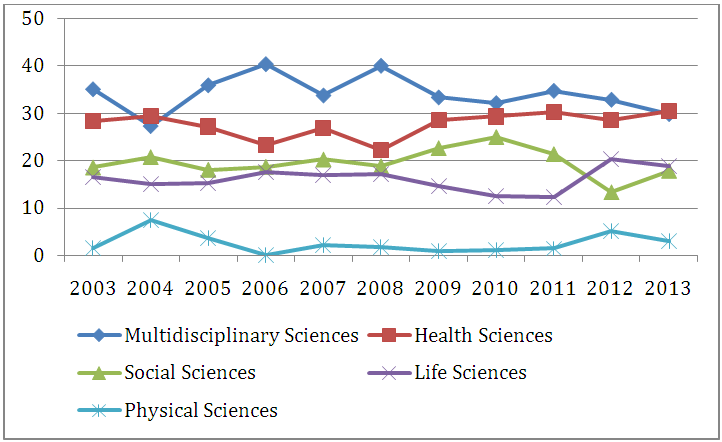 | Figure 1. Progress of relative frequency (%) of the disciplinary dimensions in obesity-related US government documents |
 | Figure 2. Dendrogram of co-occurrence of disciplinary dimensions in the obesity-related US policies, introduced or enacted in the period 2003–2013 |
3.4. Expression of Scientific Areas in US Media Articles Related to Obesity
- In order to identify the expression of scientific areas in the US media documents related to obesity, we searched for articles in The New York Times and The Washington Post. The resulting database comprises 853 articles from The New York Times and 315 from The Washington Post (Figure 3).
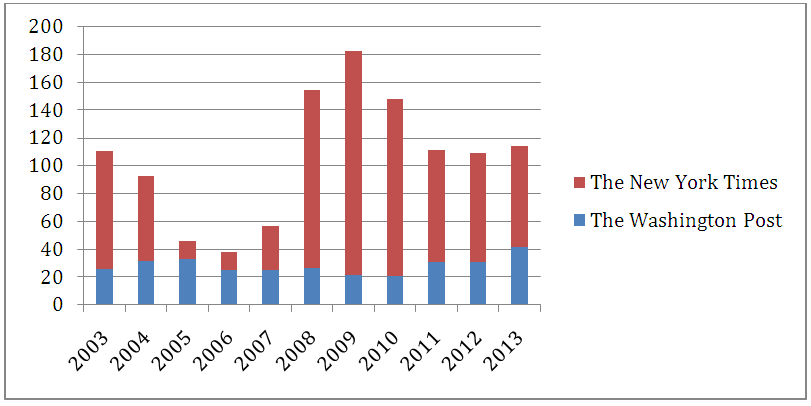 | Figure 3. Number of articles related to obesity published in The New York Times and The Washington Post |
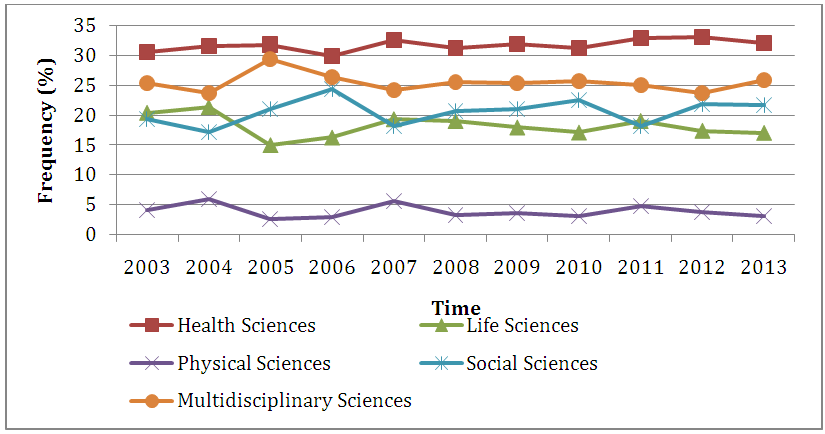 | Figure 4. Relative frequency (%) of the scientific areas in US media articles |
 | Figure 5. Dendrogram of co-occurrence of scientific areas expressed in the obesity-related articles published in The New York Times and The Washington Post in the period 2003–2013 |
3.5. Comparative Analysis of Government and Media Obesity-Related Documents in the United States
- Figure 6 shows the relative frequencies of the expression of the scientific areas in the documents related to obesity in public policies of the US states and in American press articles. Government documents placed more emphasis on the Multidisciplinary dimension of obesity while Health Sciences dominate the articles published by the two major American newspapers.
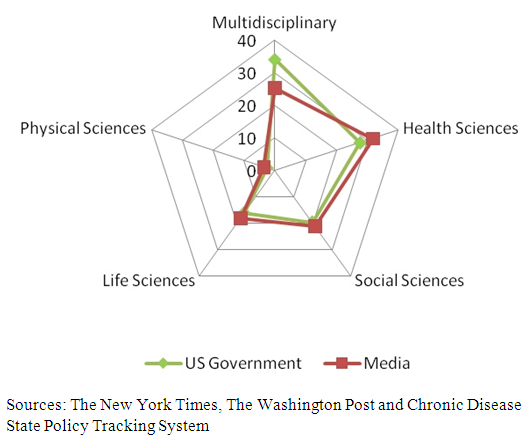 | Figure 6. Relative frequency (%) of the expression of scientific areas in US media articles and public policies of US states related to obesity (2003–2013) |
|
3.6. Agenda-Setting and Framing Analysis
- In order to interpret the findings described above, we used agenda-setting theory, suggested by Rogers and Dearing [25]. The term ‘agenda’ used by the authors refers to a list of issues and events that take place at a particular time and ranked according to their perceived importance. Agenda-setting analysis provides an understanding of the relationships between public, media, and government.Concerning the media agenda, the authors state that the media’s function is perpetuated through socialization of the points of view of the media elite, editors, and journalists. In this sense, traditional practices and values of media professionals form the media agenda. The public agenda refers to both the identification of the issues that are being discussed by the public and the influence of the media on the public perception of these issues, according to how the media frames a subject. The government or political agenda operates to solve social problems and to institutionalize a response to those problems according to the agendas of different stakeholders, such as the media and public [26]. In this study we examined only the media and government agendas, represented here by public policies related to obesity. Roberts et al. [27] and Scheufele and Tewksbury [28] highlighted the frequency with which a subject is mentioned can be an agenda-setting indicator. In this sense, our study shows that in US media publications, the frequency of articles related to obesity increased during the period 2008–2010 and declined in the period 2011–2013. In the US state government policies, the period of 2009–2011 encompassed the highest number of documents related to obesity.The purpose of a frame is to select some aspects of a perceived reality and make them more salient in a text, there by facilitating identification, interpretation of causes, evaluation or recommended treatment for a problem [29]. According to Entman [30], frames used by the media emerge through the presence or absence of keywords, common phrases, images, information sources, and their connections. When it search for keywords representing a specific scientific area in a text, it is looking at how a specific subject is scientifically framed in that text. The frequency of occurrence of these d-words is related to the emphasis that is given to the respective scientific area in the process of framing. The framing process is dynamic and can be change over time [32]. In this sense, we noted that the scientific framing of obesity varied during the studied period, more so in government than in media documents.In general, this study showed that Health Sciences and Multidisciplinary Sciences were the most frequent areas in the scientific publications. The frequency of Life Sciences, Social Sciences, and Physical Sciences were lowest. We observed that these scientific areas are present in both government and media documents, although in different proportions. These findings show that the methodology used in this study can be useful for the identification of scientific areas that should be given more attention by government and media when dealing with obesity.
4. Conclusions
- The purpose of this paper was to identify the scientific areas within which the US governments and American media have framed obesity over time. To analyse this problem, a documentary analyse was conducted using a database of US public policies and media articles related to obesity. This study emphasizes that science is a key basis for the development of public policies and we noted that government and media use the elements expressed by science in their agendas related to obesity.The primary conclusion is that the US government and media have framed the obesity in different proportions. The differences may result from a particular context, such as public and political influence, personal experiences of publishers, and social indicators as expenditures with public health, increase in cardiovascular diseases and diabetes. Second, the composition of the contents of the governmental and media documents, using Jaccard’s coefficient of similarity, revealed the existence of different approaches between them. There is more similarity among all scientific areas in the media articles than in US documents. There is a constantly concerned about how science impacts society and how scientists should help support social advances. This subject is raised recurrently in scientific forums [32]. This study shows that scientific research is indeed taken into account when media and government fulfil their social functions regarding the pandemic questions of obesity. The contemporary scientific knowledge has been used extensively as fundament for US public obesity policies, related to people’s social behaviour, food consumption, and food production. An important theoretical contribution of this study is that science must be used to support public policies and to contribute for reversal of obesity pandemic. The public policies based on science are more likely to be efficient and useful to influence media and public agendas. These results are in line with the various recent studies that identify the important role of government in this question. For example, some recent public policies in the United States have led to the stabilization, and in some cases, to the reduction of obesity rates in certain populations [33, 34]. This study demonstrated the utility of text mining techniques to extract useful quantitative data from the large sample of texts. In this study, this technique provided us relevant insights on how science are using by government and media stakeholders. The same approach may be applied to other areas and may give similar insights in future studies.Finally, this study presents certain limitations that authors may overcome in future studies. First, we need to increase the number of newspapers in the sample with the aim to consider the different editorial perspectives. Second, the investigation of how obesity correlates to the presence of different dimensions within public policies may reinforce the importance of the analyse process.
 Abstract
Abstract Reference
Reference Full-Text PDF
Full-Text PDF Full-text HTML
Full-text HTML
